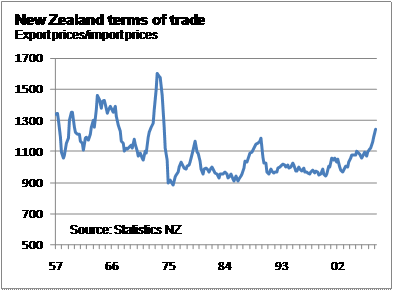Meeting Asia’s appetite
The rise and rise of commodity prices reflects an economic revolution occurring in New Zealand’s backyard. The breadth of this commodity boom is impressive and is being driven by two fundamental forces – population and income growth. That suggests that high commodity prices may persist for several more years, and possibly even a decade or two. In some cases the liftin prices could be permanent.
The last big commodity cycle was back in the early 1970s when agricultural prices surged on the back of fast population growth and poor agricultural practices especially in what was then the Soviet Union. Food prices in real terms in the 1970s were, in some cases, several times higher than they are now.
New Zealand experienced a big lift in prices for most commodities and the terms of trade leapt 45% in the space of just two years. The oil crisis followed and the boom times of the early 1970s (for New Zealand) were replaced with debilitating inflation and anaemic growth.
The current commodity cycle looks altogether different from the early 1970s boom, especially in terms of its potential longevity. But it is dangerous to start claiming that the world has changed. Too often such changes prove surprisingly fleeting, witness the short-lived new economy of the late 1990s.
The reason this commodity cycle might prove longer-lasting than any we have seen for possibly a century is that more people with higher incomes, particularly in emerging economies, are pushing up demand for resources.
Since 1970 the world’s population has grown by more than two billion people, or around 50%, and it is likely to increase by another 50% by 2050.
More importantly, the economies of a significant bunch of the world’s poorer countries in 1970 have been growing rapidly and these countries now have sizeable middle class populations. China and India probably have more people with incomes equivalent to middle income Americans than does the US. Over the next couple of decades the number of middle income Asians will most likely double, as fast economic growth seeps down to the vast number of people waiting to engage in the formal economy.
China and India are by no means the only economic bolters in Asia. Vietnam with 86m people and Indonesia with 237m are just two up-and-coming economies that are quickly hoisting hoards of households into developed economy status. These households will have the incomes, spending power and desire to consume resources – more and better food, fuel and energy, better housing, household appliances that we take for granted, etc.
Although the rate of population growth may well slow in Asia over the next 30 years, there will remain a huge number of people in these countries waiting to join the formal economy and get the skills, incomes, and job security that will enable them to live more comfortably. Just think for a moment, as you read this, what it would be like if just 50% of Chinese and Indian families were able to live like you are now – heater going, the car in the garage, appliances galore, any amount of food in the fridge, not to mention the economic infrastructure that makes it a convenient and comfortable place to live.
The claim on the world’s resources would be huge. What we are seeing in commodity markets is the start of that claim, as China, et al, purchase the raw materials to make the fridges, TV’s, buildings, pizzas and curries many more of their citizens can now afford. Already China’s citizens consume roughly 75% as much meat per capita as Europeans, or around half what the average American consumes.
South Korea, Taiwan and Singapore have achieved this economic vault into the rich world within the past 30 years. There’s certainly no reason why larger economies such as China and even Indonesia won’t do the same by the middle of this century.
The heart of this commodity boom is the economic revolution in Asia. But the oil-rich countries are also experiencing rapid economic growth. The Russian economy, for instance, is also growing at 8% pa on the back of gushing oil and gas revenues. At least some of that money is being spent on food and materials – they can now afford to buy our high-priced butter!
There are a range of other factors that have been pushing commodity prices higher including: drought, natural disasters; demand for bio-fuels; the higher cost of agricultural inputs; low stocks. But these are passing events compared with the driving force of more people with higher incomes. For New Zealand the opportunity is huge given our ability to produce high quality food and the proximity of populous countries with plenty of potential for fast economic growth.





